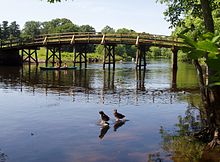Old North Bridge
| Old North Bridge | |
|---|---|

Reconstruction of the 1760s version of North Bridge.
|
|
| Crosses | Concord River |
| Locale | Concord, Massachusetts |
| Characteristics | |
| Material | Wood |
| History | |
| Rebuilt | 2005 |
| Closed | 1793 |
The North Bridge, often colloquially called the Old North Bridge, is a historical site in the Battle of Concord, the first day of battle in the American War of Independence. The current wooden pedestrian bridge is a replica of the one that stood at the day of the battle. It and nearby sites are now part of the Minute Man National Historical Park of the National Park Service, an extremely popular tourist destination.
The current bridge is located in its original location off Monument Street in Concord, Massachusetts. It spans the Concord River 0.5 miles northeast from the start of the river at the confluence of the Assabet River and the Sudbury River at Egg Rock.
In 1775, five companies of Minutemen and five of non-Minuteman militia occupied a hill near the bridge with groups of other men streaming in, totaling about 400 against the British light infantry companies from the 4th, 10th, and 43rd Regiments of Foot under Captain Walter Laurie, a force totaling about 90-95 men. The British retreated across the river and the two sides faced each other across the North Bridge.
A brief exchange of fire ensued which saw the first instance of Americans firing to deadly effect on British regulars, after which the British retreated. Ralph Waldo Emerson, positing that world history pivoted at that moment (an assertion that is disputed, as earlier events at Lexington Battle Green could be termed the true opening of the battle), called the first shot of this skirmish the "shot heard round the world" in his 1837 poem "Concord Hymn".
The original North Bridge was dismantled in 1793 by the town of Concord because its use as a bridge had become impractical; a new bridge was erected a few hundred yards away. The bridge was rebuilt multiple times in 1875, 1889, and 1909. The current replica was built in 1956 and was based on drawings of the bridge built in the 1760s. The bridge was restored in 2005.
...
Wikipedia
